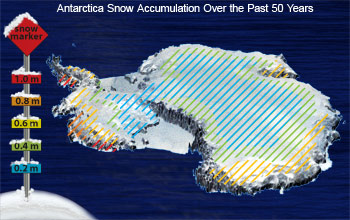Snow in Antarctic not falling to counter sea level rise
Snow in Antarctic not falling to counter sea level rise
National Science Foundation
August 10, 2006
The most precise record of Antarctic snowfall ever generated shows there has been no real increase in precipitation over the southernmost continent in the past half-century, even though most computer models assessing global climate change call for an increase in Antarctic precipitation as atmospheric temperatures rise.
“The year-to-year and decadal variability of the snowfall is so large that it makes it nearly impossible to distinguish trends that might be related to climate change from even a 50-year record,” said Andrew Monaghan, a research associate with Ohio State University’s Byrd Polar Research Center and lead author of an article on the topic published in the Aug. 10 edition of Science magazine.
“There were no statistically significant trends in snowfall accumulation over the past five decades, including recent years for which global mean temperatures have been warmest,” Monaghan said.
 Scientists say the mean snowfall in Antarctica hasn’t changed during the past 50 years, despite evidence of global warming. Most snow fell near the coasts (red), while the inland regions received the least (blue). Credit: Nicolle Rager-Fuller, National Science Foundation
|
The findings also suggest thickening of Antarctica’s massive ice sheets haven’t reduced the slow-but-steady rise in global sea levels, as some climate-change critics have argued.
The study looked at both the West Antarctic Ice Sheet (WAIS), a marine ice sheet with a base below sea level, and the much thicker East Antarctic Ice Sheet (EAIS) that sits atop dry land. In recent years, large volumes of ice along the WAIS coast have melted at a faster rate than previously seen. Some observers have blamed global warming for the melting and for the increased calving of icebergs along the continent’s margin.
The 16 researchers from nine institutions in seven countries wanted to assemble a half-century-long record of snowfall back to the International Geophysical Year, or IGY. Work during the IGY began the first real modern study of the Antarctic continent and substantive research has continued there ever since. That work will continue in 2007-2008 during the upcoming International Polar Year (IPY), including NSF-funded studies of ice-sheet dynamics.
This is a modified news release, “Overall Antarctic Snowfall Hasn’t Changed in 50 Years”, from the National Science Foundation.